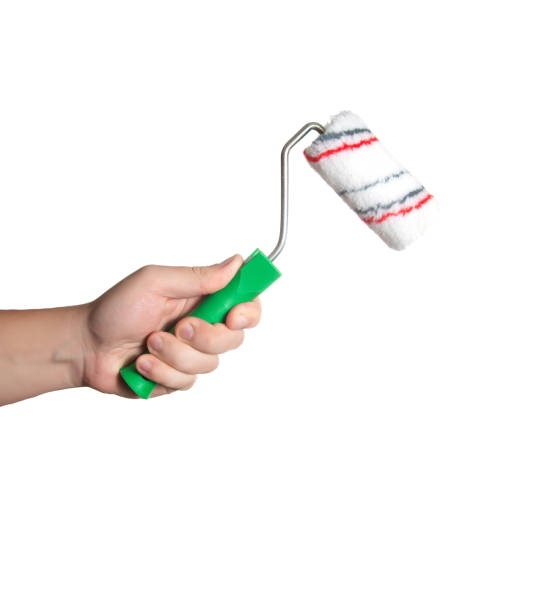Painting your home can be a fun and rewarding experience. Not only can it help you transform the look of your living space, but it can also be a therapeutic way to express yourself creatively. However, painting can be intimidating for many people, particularly when using a paint roller. However, anyone can use a paint roller like a pro with the right tools and techniques. This article will explore some DIY painting tips to help you achieve a smooth, even finish every time.

Basic Painting Tips
Choose the Right Roller
Choosing the right roller is the first step in achieving a professional-looking paint job. Many rollers are available on the market, each designed for specific types of paint and surfaces. Here are a few guidelines to help you select the right roller for your project:
- Nap length: The nap length refers to the thickness of the roller cover. A shorter nap length (around ¼ inch) is generally recommended for smooth surfaces, such as walls and ceilings. A longer nap (up to 1 inch) may be necessary for rougher surfaces, such as textured walls or stucco.
- Material: Roller covers are made from various materials, including synthetic materials like polyester and nylon and natural materials like lambswool. Synthetic covers are generally more durable and better suited for latex paints, while natural covers are better for oil-based paints.
- Quality: Choosing a high-quality roller cover ensures a smooth and even application. Cheaper rollers may shed fibres or leave streaks on the surface, resulting in a less professional-looking finish.
Use a Paint Grid
Before you begin painting, preparing your roller by removing any loose fibres or debris is important. You can do this by wrapping masking tape around the roller cover and then peeling it off. Once your roller is clean, it is time to load it with paint. Rather than using a traditional paint tray, however, consider using a paint grid. A paint grid is a rectangular metal or plastic screen that fits inside your paint bucket. Rolling your roller back and forth over the grid can remove excess paint and achieve a more even application.
Apply Paint in a “W” Pattern
Once your roller is loaded with paint, you can start painting. Applying the paint in a “W” pattern is important when painting the wall with a paint roller. Work starting at the top of the wall and rolling down in a W-shaped pattern, then filling in the pattern with horizontal strokes. This will help to distribute the paint evenly and avoid streaks or lines.
Don’t Overload Your Roller
One common mistake many DIY painters make is overloading their roller with paint. While applying a thick layer of paint to cover the surface more quickly may be tempting, this can result in a less professional-looking finish. Overloading your roller can cause drips and runs and a thick, uneven layer of paint. Instead, focus on applying thin, even coats of paint, allowing each coat to dry completely before applying the next.
Use a Pole for Hard-to-Reach Areas
Reaching the top without a ladder can be difficult when painting ceilings or tall walls. However, using a ladder can be dangerous and time-consuming. Instead, consider using a paint roller pole. A paint roller pole is a long handle that attaches to your roller, allowing you to reach high areas without a ladder. This can make painting ceilings and tall walls much easier and safer.
Keep Your Roller Clean
Keeping your roller clean throughout the painting is important. If the paint gets dry on the roller, it can create problems that will influence the wall and ruin the finish. To clean your roller, periodically roll it over a cardboard or paper towel to remove excess paint. If you want to take a break during the painting process, wrap your roller in a plastic bag or aluminium foil to prevent the paint from drying.
Use a Second Coat
Once you finish the first coat on the wall, it is necessary to apply a second coat. A second coat can help to create a more durable finish. But before applying the second coat, you need to sand the surface with fine-grit sandpaper to remove any bumps or imperfections. Then, you can apply the second coat using the same techniques as the first.
Clean Up Properly
Once you have finished painting, it is important to clean up properly. Rinse your roller cover thoroughly with warm water or solvent (depending on the type of paint you used), and then hang it to dry. Store your roller cover in a dry place until your next painting project. Dispose of any paint or paint-related materials according to your local regulations.
With these DIY painting tips, anyone can use a paint roller like a pro. Remember to choose the right roller for your project, use a paint grid to remove excess paint, apply paint in a “W” pattern, avoid overloading your roller, use a pole for hard-to-reach areas, keep your roller clean, use a second coat for an even finish, and clean up properly, etc. By following these tips, you can achieve a smooth, even, and professional-looking paint job in no time. Happy painting!
More Advanced Painting Techniques
In addition to these basic tips, a few more advanced techniques can help you take your painting skills to the next level. Here are a few more tips to consider:
Cut in with a Brush
When painting around trim, corners, or other tight spaces, getting a clean line with a roller alone can be difficult. In these cases, using a brush to “cut in” around the edges of your painting area is helpful. Use a small, angled brush to apply paint in a straight line, then roll over the area with your roller to blend the paint in.
Use a Paint Extender
A paint extender is a product that can be added to your paint to help it dry more slowly and evenly. This can be particularly useful when working with large surfaces or in hot, dry conditions, which can cause the paint to dry too quickly and result in a rough or uneven finish. Adding a paint extender can help the paint to level out and create a smoother, more professional-looking finish.
Use a Wet Edge
When painting large surfaces, it is important to maintain a “wet edge” as you work. This means keeping a line of wet paint at the edge of the area you are painting and working quickly to blend new paint into it before it dries. Allowing the paint to dry completely before applying the next section can create a visible line or “lap mark” where the two sections meet.
Experiment with Textures
While most people think of paint as a way to create a smooth, even surface, it can also create interesting textures and patterns. Experiment with techniques like stippling, dragging, or sponging to create unique effects on your walls or furniture. Practice on a test surface first to ensure you achieve the desired result.
By following these tips and techniques, you can take your DIY painting skills to the next level and achieve a professional finish. Remember to take your time, choose the right tools and materials, and practice on a test surface before tackling a larger project. With patience and practice, you can transform your living space and create a beautiful, personalized environment you will love for years.
